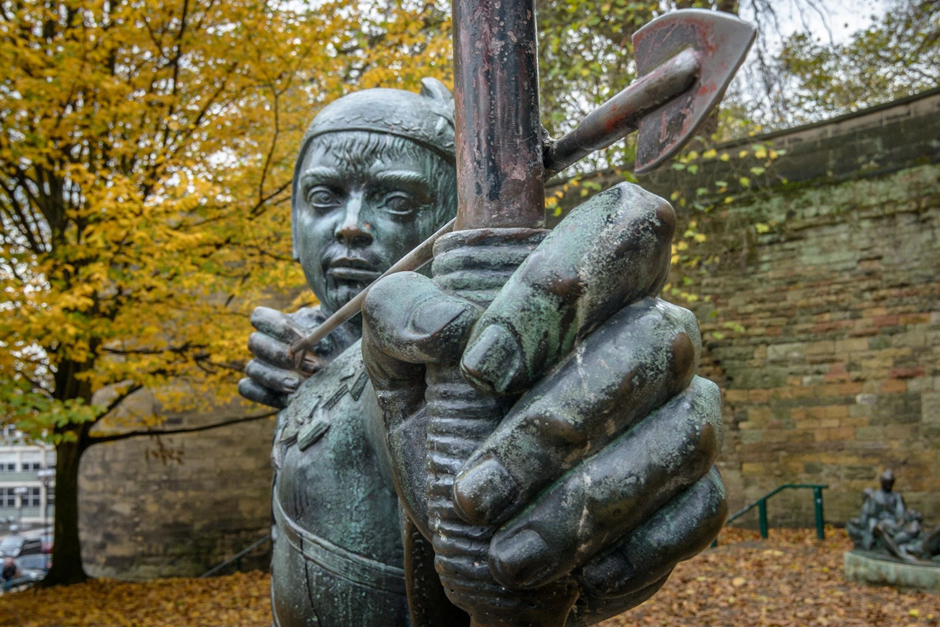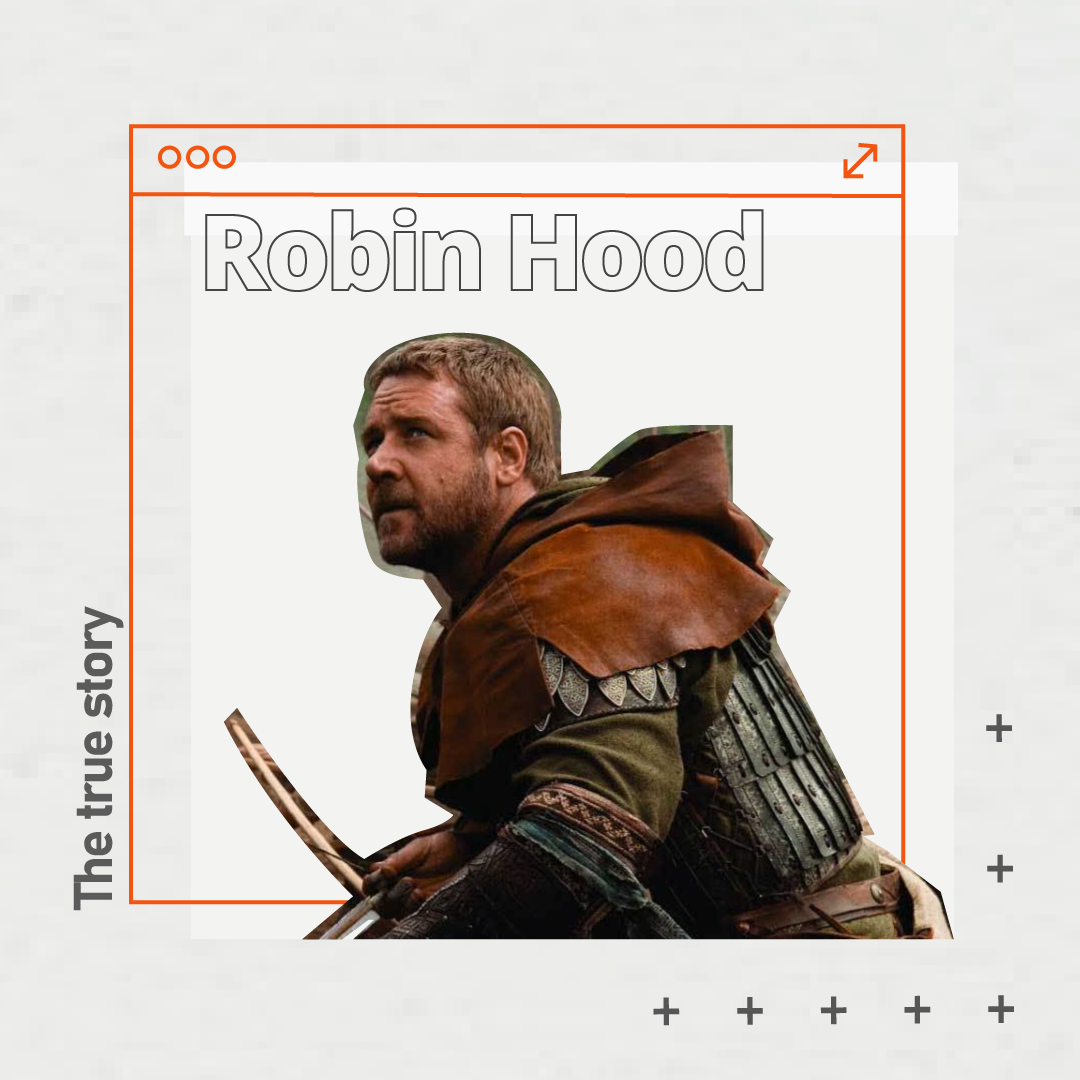The story of Robin Hood is well known: a highwayman who lives in the English forests, as well as a goodhearted outlaw, because he “robs the rich to give to the poor”. Since Middle Ages time, there have been hundreds of literary, theatrical and film adaptations of the popular English character. But what do we really know about Robin Hood? Here we will let you know a little more about the legend.
Fight over power
The first surprising fact about Robin Hood is that nobody knows who he was, and it is not even known if such a person existed. Many historical investigations tried to pin down his identity, but all of them were not successful. Both the names «Robert» and «Robin» and the surname «Hood» were quite common in the medieval England. Therefore, we should be glad just with the legend.

What is clear in connection with the story is that it was set in the forests near the city of Nottingham, right in the centre of the country, at the beginning of the 13th century, during the reign of Juan Sin Tierra. That Monarch, who became King in 1199 after the death of his brother, developed a strict policy to centralize his power to the detriment of the local nobles, since he implemented more taxes and deprived them of their lands and titles if they resisted. . Indeed, it is believed that Robin Hood could have been a noble who was against the king, since that would explain, on the other hand, his extraordinary skill with the bow and arrow.

City of Nottigham, origin of the Robin Hood legend
Thus, the legend places him as an outlaw, who acted under an ideal of justice that was opposed to laws that he considered unjust. It is this idea of justice at all cost and the confrontation with the powerful that has made him so popular. In addition, he is considered as a great helper of the most needy. Due to some situations in those days in which gangs of assailants abounded on the roads, and the freedom was granted by the forests to hide from persecution, the myth was associated with this scenario. On the other hand, it is believed that the figure of Robin Hood also symbolizes the Anglo-Saxon cause against the Norman invasions in England.
The core of the story is the following: Robin Hood is about to marry his girlfriend Lady Marian when Prince John’s soldiers break in and declare him outlawed. After this act, the couple is separated, and Robin Hood flees to Sherwood Forest with his friends, where he becomes the «Prince of Thieves», until he meets a mysterious knight, King Richard who returns from the Crusades and restores his noble title forgiving him. Meanwhile, Lady Marian is wanted by Juan Sin Tierra, until she flees to the forest where she can marry her fiancé.

Robin Hood Bay, named after the legend
The story first came out in the year 1450, and from that moment on, it has not stopped being replicated, always being adapted to the different contexts and atmosphere of times. The first novel written is dated in 1819, by Walter Scott, while the first children’s adaptation is from 1883. As for theatre and audio-visual arts, the first opera is from 1860, the first film from 1908 and the first cartoon is from 1936.
Linguistic curiosities
It is often believed that «Hood» derives from «wood» (which means «forest» in English), due to the forest hideout of this character; However, the truth is that «hood» means both «hood» and «truhan» (scoundrel, deceiver). The most probable thing, then, is that Robin has acquired his “last name” due to his activities as an outlaw, then adding the hat to disguise this controversial origin.
In medieval England, it used to be called «Robinhood» all those considered outlaws by legal provisions, and by extension, all the gangs of outlaws that swarmed the roads, so the name of this character is probably more collective than individual. This moved to The United States, where gangsters and other people in the criminal world are now called “hood”, regardless of their intentions.

Robin Hood, la leyenda
La historia de Robin Hood es muy conocida: un bandolero que vive en los bosques ingleses, fuera de la ley pero con buen corazón, ya que “le roba a los ricos para darle a los pobres”. Desde la Edad Media, hubo cientos de adaptaciones literarias, teatrales y cinematográficas sobre el popular personaje inglés. Pero, ¿qué sabemos en verdad sobre esta figura? A continuación te contamos un poco más sobre este icono.
Conflicto por el poder
El primer dato sorprendente sobre Robin Hood es que no se sabe quién fue, y ni siquiera se conoce si realmente existió alguien así. Muchas investigaciones históricas trataron de precisar su identidad, pero no lo lograron a ciencia cierta. Tanto los nombres “Robert” y “Robin” como el apellido “Hood” eran muy comunes en la Inglaterra medieval, por lo que debemos contentarnos con su carácter de leyenda.

Lo que sí es claro es que su historia está ambientada en los bosques cercanos a la ciudad de Nottingham, bien en el centro del país, a principios del siglo XIII, durante el reinado de Juan Sin Tierra. Este monarca, quien accedió al trono en 1199 luego de la muerte de su hermano, desarrolló una política estricta que buscó centralizar su poder, en desmedro de los nobles locales, a quienes pretendió cobrar más impuestos y despojar de sus tierras y títulos si se resistían. De esta forma, se cree que Robin Hood podría haber sido un noble rebelde contra el rey, lo que explicaría, por otra parte, su proverbial habilidad con el arco y la flecha.

Ciudad de Nottigham, origen de la leyenda de Robin Hood
Así, la leyenda lo sitúa como un forajido fuera de la ley, que actuaba bajo un ideal de justicia que se oponía a las leyes consideradas injustas. Es esta idea de la justicia aún a costa del enfrentamiento con el poder lo que vuelve tan popular a esta figura, considerada tradicionalmente como un gran ayudante de los más necesitados. Debido a las condiciones de la época, en la que abundaban las bandas de asaltantes en los caminos, y la libertad que otorgaban los bosques para esconderse de las persecuciones, el mito quedó asociado a este escenario. Por otra parte, se cree que la figura de Robin Hood simboliza también a la causa anglosajona en contra de las invasiones normandas que sufrió Inglaterra.
El núcleo de la historia es el siguiente: Robin Hood se está por casar con su novia Lady Marian cuando irrumpen los soldados del Príncipe Juan y lo declaran fuera de la ley. Tras este acto, la pareja es separada, y Robin Hood huye al bosque de Sherwood con sus amigos, donde se convierte en el “Príncipe de los Ladrones”, hasta que conoce a un misterioso caballero, el rey Ricardo que vuelve de las Cruzadas, quien le devuelve su título nobiliario y lo perdona. Mientras tanto, Lady Marian es pretendida por Juan Sin Tierra, hasta que huye al bosque donde se puede casar con su prometido.

Bahía Robin Hood, llamada así en honor al personaje
La primera aparición de este relato data del año 1450, y desde ese momento, no dejó de replicarse, siempre adaptada a los distintos contextos y climas de época. La primera novela escrita con su historia es del año 1819, por Walter Scott, mientras que la primera adaptación infantil es de 1883. En cuanto a las artes teatrales y audiovisuales, la primera ópera es de 1860, la primera película de 1908 y el primer dibujo animado es de 1936.
Curiosidades lingüísticas
Se suele creer que “Hood” deriva de “wood” (que significa “bosque” en inglés), debido al escondite forestal de este personaje; sin embargo, lo cierto es que “hood” significa tanto “capucha” como “truhan” (sinvergüenza, engañador). Lo más probable, entonces, es que Robin haya adquirido su “apellido” debido a sus actividades al margen de la ley, sumando luego el sombrero para disimular este polémico origen.
En la Inglaterra medieval, solía además llamarse “Robinhood” a todos los considerados fuera de ley por disposiciones legales, y por extensión, a todas las bandas de forajidos que pululaban por los caminos, por lo que probablemente el nombre de este personaje sea más colectivo que individual. Esto se trasladó a Norteamérica, donde actualmente se denomina “hood” a los gángsters y otras personas del mundillo delictivo, más allá de la justicia o no de sus intenciones.
La lengua, al igual que la sociedad, muta y va reflejando y construyendo nuevas realidades. La lucha por utilizar un lenguaje inclusivo que no ofenda y que respete las identidades de todas las personas va ganando espacio y generando un clima más respetuoso para con todos, todas y todes.
Si te gustó esta nota dejanos un comentario o compartila en las redes y etiquetanos así nos enteramos
Conocé más sobre nosotros en nuestra Página Web, Instagram, Facebook, LinkedIn, Blog, TikTok, Lasso, y aprendé inglés online.
Sumate a nuestro newsletter para recibir novedades sobre nuestros cursos.
Gracias a Lucio Maciá por la nota, Cecilia Musis por la traducción al inglés, Araceli Sabransky por las publicaciones para instagram, y Christian Trappani por la organización.
#robinhood #nottingham #bosque #bandolero #fugitivo #ladymarian #juansintierra #inglaterra #culturainglesa #justicia #poder #ley #arquero #medieval #inglés #aprenderinglés #glosaidiomas

